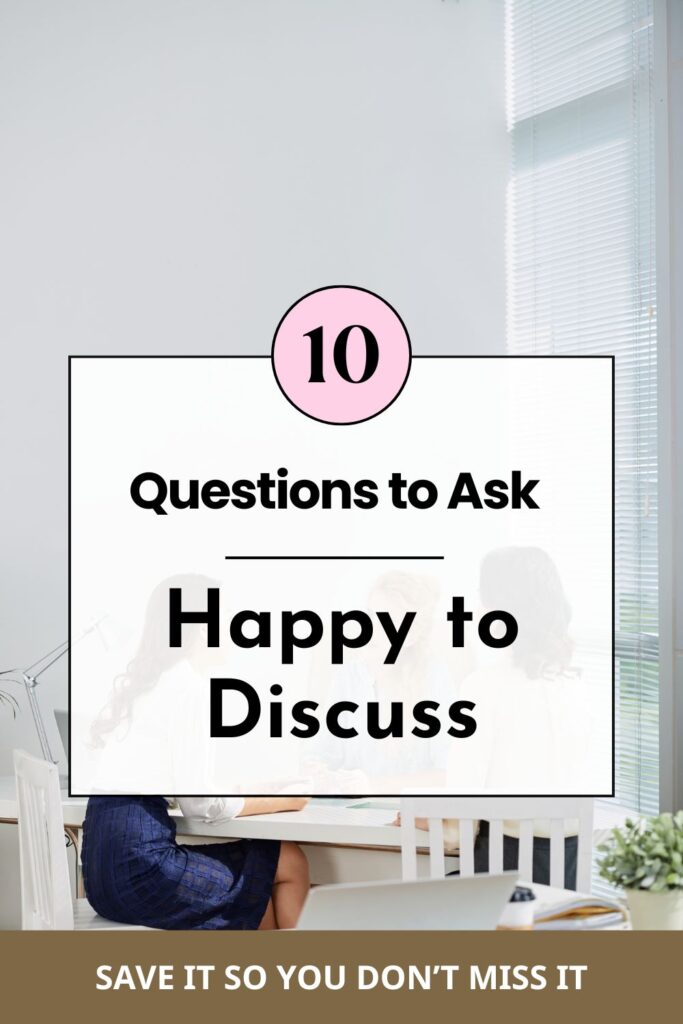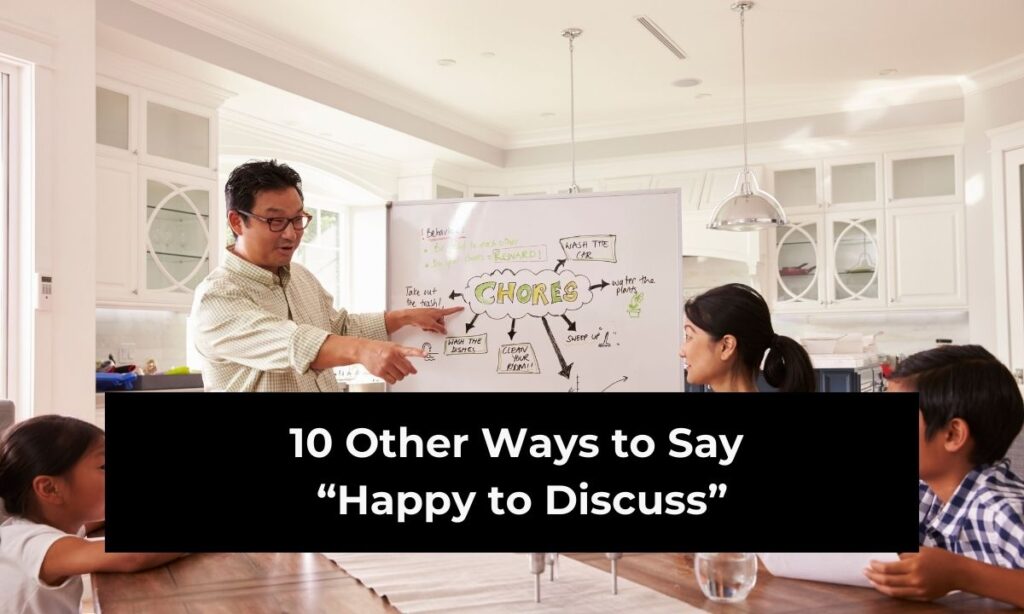When you’re writing emails, preparing for a meeting, or chatting with a colleague online, you often need to show that you’re open to conversation. The phrase “Happy to discuss” has become one of the most common go-to expressions. While it’s professional and polite, you may worry that it sounds repetitive, overly formal, or even a little dull when you use it too often.
If you want your messages to feel fresh, approachable, and personal, it’s a good idea to have a few alternatives in your toolkit. Choosing the right words can help you come across as confident, warm, and approachable, which is especially important when you’re building professional relationships or working on collaborative projects.

In business communication, variety in phrasing matters more than you think. Imagine you send five emails in one week, and each one says “Happy to discuss.” It might feel robotic to the reader, as though you’re just copying and pasting the same line over and over. By using different ways to say the same thing, you make your communication more natural, adaptable, and personal.
This guide gives you ten creative, professional, and versatile alternatives to “Happy to discuss.” Each option comes with a breakdown of when to use it, why it works, and how it might be received in different situations. Whether you’re emailing a client, messaging your boss, or chatting casually with a coworker, you’ll have the perfect phrase ready.

So, if you’ve ever wondered how to say “Happy to discuss” without sounding like a broken record, keep reading. You’ll discover practical examples and communication tips that will make your emails, messages, and conversations flow more smoothly and leave a stronger impression.
1. “I’d Be Glad to Talk This Through”
This phrase is warm, approachable, and supportive. Unlike “Happy to discuss,” which can sometimes feel like a formality, saying “I’d be glad to talk this through” shows genuine willingness to work together. It emphasizes collaboration, not just availability.
Use this alternative when you want to reassure the other person that you’re not only open to discussion but also invested in helping them move forward. It’s especially effective in situations where the topic may feel complex or even stressful for the recipient. By framing your willingness with “glad,” you add a positive and encouraging tone.
For example, in a workplace scenario, you might write:
“Thanks for raising those concerns. I’d be glad to talk this through and find the best solution together.”
This makes the other person feel heard and supported, rather than simply being told that you’re “happy to discuss.” It works equally well in client emails, team updates, or one-on-one check-ins with your manager.
If you want to bring a sense of care and teamwork into your communication, this option is an excellent replacement. It avoids sounding generic while adding warmth that helps build trust.
2. “Let’s Connect on This Further”
This version takes a more proactive approach. Instead of simply saying you’re open to talking, it signals initiative by inviting the other person to engage. The phrase “let’s connect” has become increasingly common in professional settings, especially with the rise of remote and hybrid work where digital collaboration is the norm.
The benefit of this phrase is that it positions the discussion as a shared effort. You’re not just passively waiting for the other person to reach out—you’re actively suggesting that the two of you continue the conversation. That little shift can make your message feel more dynamic and solution-oriented.
For example, you might use it in a client-facing email like this:
“I appreciate your feedback on the proposal. Let’s connect on this further to make sure it aligns with your expectations.”
This alternative works well when you want to keep communication lines open without sounding too formal. It blends professionalism with a friendly, approachable style, which is great for relationship-building.
By choosing this phrase, you highlight collaboration and forward momentum, which is especially effective in project discussions, brainstorming sessions, or partnership conversations.
3. “I’m Open to Talking More About It”
Sometimes the simplest wording is the most effective. “I’m open to talking more about it” is clear, straightforward, and approachable. It conveys a willingness to listen and participate without unnecessary formality.
This phrase works best in casual or semi-formal settings. For instance, if a colleague suggests a new idea in a meeting, you might respond:
“That’s an interesting point. I’m open to talking more about it and seeing how we can make it work.”
Using “open” here signals flexibility, which can make others feel more comfortable sharing their thoughts. It’s especially effective in brainstorming sessions, team collaborations, or situations where you want to foster a non-judgmental, welcoming atmosphere.
Unlike “Happy to discuss,” this version avoids sounding routine. It’s conversational and makes your communication feel more human, which is something people appreciate in both professional and personal exchanges.
4. “Feel Free to Reach Out Anytime”
If you want to encourage ongoing communication, this phrase is a strong choice. It goes beyond simply stating that you’re happy to discuss—it removes barriers by inviting the other person to contact you whenever they need.
The phrase is warm, inviting, and adaptable. It works well in client communication because it reassures them that they have access to your support whenever necessary. In team settings, it signals that you’re approachable and ready to help.
For example:
“Thanks for reviewing the draft. Feel free to reach out anytime if you’d like to go over the details together.”
One of the strengths of this alternative is that it shifts the power to the other person. They don’t have to wait for you to set a time—they know they can contact you when it works for them. This helps reduce pressure and builds trust.
If you want to emphasize availability and openness, this phrase is an excellent choice.
5. “I’d Love to Hear Your Thoughts”
This version emphasizes listening rather than just talking. It’s not only about your willingness to discuss—it highlights genuine interest in the other person’s perspective. That makes it particularly effective in situations where feedback or collaboration is important.
For example, in a professional setting, you might write:
“I’d love to hear your thoughts on this plan so we can make sure it works for everyone involved.”
The phrase “I’d love” adds warmth and enthusiasm, which helps you come across as approachable and invested. It’s particularly useful when you want to encourage open dialogue and show that you value the other person’s opinion.
Unlike the more standard “Happy to discuss,” this option makes your communication sound more engaging and less transactional. It signals collaboration, curiosity, and respect—all qualities that strengthen professional relationships.
6. “Let Me Know When You’d Like to Talk”
This phrase puts control in the other person’s hands, which can be very helpful in professional communication. By asking them to decide the timing, you’re showing respect for their schedule and availability.
It works especially well in situations where the other person may be busy or juggling multiple priorities. Instead of pressing them to engage right away, you give them flexibility.
For example:
“I’m available to go over this in more detail. Let me know when you’d like to talk.”
This phrase is straightforward and polite, making it versatile across different settings. It avoids sounding overly formal while still maintaining professionalism.
By using this option, you come across as considerate and accommodating, which can help strengthen working relationships. It’s a simple but highly effective way to replace “Happy to discuss.”
7. “Always Happy to Chat More”
This alternative has a friendly, approachable tone. It conveys openness to conversation while also adding a touch of warmth with the word “always.” It’s especially useful in ongoing relationships where you want to signal long-term availability, not just one-time support.
For instance, you might say in an email to a colleague:
“Thanks for sharing your perspective. Always happy to chat more if you’d like to dive deeper.”
The phrase works well when you want to encourage continued dialogue without making the interaction feel transactional. It’s informal enough to sound conversational but still professional enough to fit into workplace communication.
If you want to balance professionalism with friendliness, this option is a great alternative. It’s a good way to make your messages feel less stiff and more approachable.
8. “We Can Go Over This Together”
This phrase emphasizes teamwork and collaboration. Rather than just saying you’re available, it shows that you’re willing to work side by side to solve a problem or clarify details.
It’s particularly effective in situations where cooperation is key, such as project planning, troubleshooting, or brainstorming sessions.
For example:
“I know this section is a bit complex. We can go over this together and figure out the best approach.”
This alternative makes you sound supportive and encouraging, rather than detached. It helps the other person feel like they’re not tackling the issue alone but instead have a partner in the process.
By choosing this phrase, you strengthen the sense of teamwork, which is invaluable in professional relationships. It’s a softer, more collaborative alternative to “Happy to discuss.”
9. “I’m Available to Talk It Through”
This phrase is direct, professional, and flexible. It communicates both your availability and your willingness to engage, without unnecessary formality.
Use it in situations where clarity and efficiency matter most. For example, in a project update, you could write:
“I’m available to talk it through if you’d like more details before we move ahead.”
The strength of this phrase lies in its straightforwardness. It’s easy to understand, doesn’t feel forced, and fits comfortably into almost any professional setting.
Unlike some warmer alternatives, this one is a little more neutral, making it appropriate when you want to maintain a professional but approachable tone.
10. “Let’s Schedule a Time to Discuss”
Sometimes, instead of keeping things open-ended, it’s more effective to propose setting a specific time. This phrase communicates not only your willingness but also your initiative to make the discussion happen.
It works especially well in business contexts where deadlines matter or when you need to ensure that a conversation doesn’t get delayed indefinitely.
For example:
“Let’s schedule a time to discuss the next steps so we can move forward smoothly.”
This option adds structure and shows that you’re proactive. It signals seriousness about the topic while still being polite and approachable.
By suggesting a specific time, you also make it easier for the other person to follow through, which helps avoid back-and-forth delays.
Conclusion
Using the same phrase repeatedly can make your communication feel routine and less engaging. While “Happy to discuss” is a reliable choice, it doesn’t always capture the warmth, collaboration, or professionalism you may want to convey.
By exploring alternatives like “I’d be glad to talk this through,” “Let’s connect on this further,” or “We can go over this together,” you give yourself the flexibility to adapt to different contexts. Some of these options emphasize collaboration, others highlight listening, and some focus on availability. The key is to choose the phrase that best matches the tone you want to set and the relationship you’re nurturing.
When you diversify your language, you not only avoid sounding repetitive but also communicate more effectively. You create a stronger connection with your audience, whether that’s a client, a colleague, or a manager.
So, the next time you’re drafting an email or preparing for a conversation, try one of these alternatives. You’ll find that the right words can make a small but meaningful difference in how your message is received.
FAQs
1. Why should I avoid saying “Happy to discuss” too often?
Because it can sound repetitive or impersonal if used in every message. Alternatives help keep your communication fresh and engaging.
2. Are these alternatives professional enough for formal emails?
Yes, all ten options are professional. Some are warmer and more casual, while others are structured and formal—you can choose based on context.
3. Can I use these phrases in client communication?
Absolutely. Options like “Let’s connect on this further” or “I’d love to hear your thoughts” are especially effective with clients.
4. Which alternative works best for team collaboration?
Phrases like “We can go over this together” and “Always happy to chat more” emphasize teamwork and are great for internal collaboration.
5. How do I decide which phrase to use?
Think about the tone you want to set—professional, friendly, collaborative, or structured—and pick the phrase that matches best.





